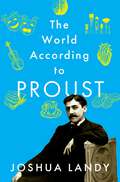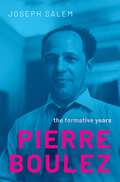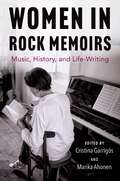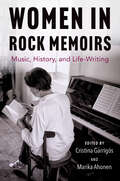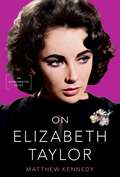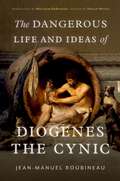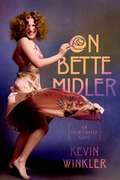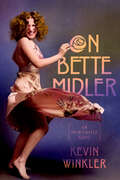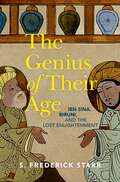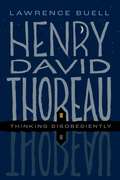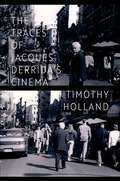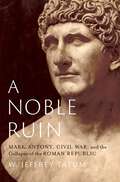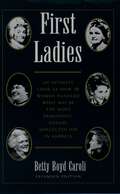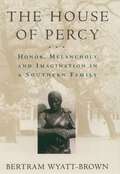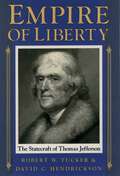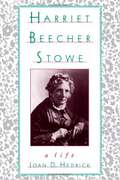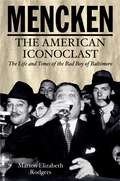- Table View
- List View
The World According to Proust
by Joshua Landy100 years after Proust's death, In Search of Lost Time remains one of the greatest works in World Literature. At 3,000 pages, it can be intimidating to some. This short volume invites first-time readers and veterans alike to view the novel in a new way. Marcel Proust (1871-1922) was arguably France's best-known literary writer. He was the author of stories, essays, translations, and a 3,000-page novel, In Search of Lost Time (1913-27). This book is a brief guide to Proust's magnum opus in which Joshua Landy invites the reader to view the novel as a single quest-a quest for purpose, enchantment, identity, connection, and belonging- through the novel's fascinating treatments of memory, society, art, same-sex desire, knowledge, self-understanding, self-fashioning, and the unconscious mind. Landy also shows why the questions Proust raises are important and exciting for all of us: how we can feel at home in the world; how we can find genuine connection with other human beings; how we can find enchantment in a world without God; how art can transform our lives; whether an artist's life can shed light on their work; what we can know about the world, other people, and ourselves; when not knowing is better than knowing; how sexual orientation affects questions of connection and identity; who we are, deep down; what memory tells us about our inner world; why it might be good to think of our life as a story; how we can feel like a single, unified person when we are torn apart by change and competing desires. Finally, Landy suggests why it's worthwhile to read the novel itself-how the long, difficult, but joyous experience of making it through 3,000 pages of prose can be transformative for our minds and souls.
The World According to Proust
by Joshua Landy100 years after Proust's death, In Search of Lost Time remains one of the greatest works in World Literature. At 3,000 pages, it can be intimidating to some. This short volume invites first-time readers and veterans alike to view the novel in a new way. Marcel Proust (1871-1922) was arguably France's best-known literary writer. He was the author of stories, essays, translations, and a 3,000-page novel, In Search of Lost Time (1913-27). This book is a brief guide to Proust's magnum opus in which Joshua Landy invites the reader to view the novel as a single quest-a quest for purpose, enchantment, identity, connection, and belonging- through the novel's fascinating treatments of memory, society, art, same-sex desire, knowledge, self-understanding, self-fashioning, and the unconscious mind. Landy also shows why the questions Proust raises are important and exciting for all of us: how we can feel at home in the world; how we can find genuine connection with other human beings; how we can find enchantment in a world without God; how art can transform our lives; whether an artist's life can shed light on their work; what we can know about the world, other people, and ourselves; when not knowing is better than knowing; how sexual orientation affects questions of connection and identity; who we are, deep down; what memory tells us about our inner world; why it might be good to think of our life as a story; how we can feel like a single, unified person when we are torn apart by change and competing desires. Finally, Landy suggests why it's worthwhile to read the novel itself-how the long, difficult, but joyous experience of making it through 3,000 pages of prose can be transformative for our minds and souls.
Pierre Boulez: The Formative Years
by Joseph SalemAs an integral figure in twentieth-century music, Pierre Boulez innovated new musical ideas through extraordinary creative processes. His formative years tracked his compositional development from his confrontations with serialism to drafting one of his major works, Pli selon pli, in the early 1960s. Part biography, part survey, Pierre Boulez: The Formative Years situates Boulez and his compositions among a complex network of influences. To best understand Boulez's creative process, author Joseph R. Salem organizes the book into three parts. First, Boulez's early life, training, and education provide biographical context for his career. Salem provides a fresh, revisionist perspective of the composer's life by drawing upon a mix of primary and secondary sources. Second, the brunt of the biography situates Boulez's musical works and experimentation among a host of contextual contexts. In place of scores and complicated musical analyses, Salem employs sketches as a visual metonym. The sketches denote Boulez's continual ability to self-reform, accept feedback from his peers, mentors, and family members, and revitalize old material. Third, Boulez's legacy is associated with contemporaneous aesthetic movements and artistic challenges. While his creative processes undoubtedly influenced music today, Boulez remains a controversial, even taboo, figure among contemporary musicians and audiences. A book that both celebrates and critiques its subject, The Formative Years urges a reconsideration of narratives and discussions surrounding Boulez's life and works.
Women in Rock Memoirs: Music, History, and Life-Writing
Women in Rock Memoirs vindicates the role of women in rock music. The chapters examine memoirs written by women in rock from 2010 onwards to explore how the artists narrate their life experiences and difficulties they had to overcome, not only as musicians but as women. The book includes memoirs written by both well-known and lesser-known artists and artists from both inside and outside of the Anglo-American sphere. The essays by scholars from different research areas and countries around the world are divided into three parts according to the overall themes: Memory, Trauma, and Writing; Authenticity, Sexuality, and Sexism; and Aging, Performance, and the Image. They explore the dynamics of memoir as a genre by discussing the similarities and differences between the women in rock and the choices they have made when writing their books. As a whole, they help form a better understanding of today's possibilities and future challenges for women in rock music.
Women in Rock Memoirs: Music, History, and Life-Writing
by Cristina Garrigós and Marika AhonenWomen in Rock Memoirs vindicates the role of women in rock music. The chapters examine memoirs written by women in rock from 2010 onwards to explore how the artists narrate their life experiences and difficulties they had to overcome, not only as musicians but as women. The book includes memoirs written by both well-known and lesser-known artists and artists from both inside and outside of the Anglo-American sphere. The essays by scholars from different research areas and countries around the world are divided into three parts according to the overall themes: Memory, Trauma, and Writing; Authenticity, Sexuality, and Sexism; and Aging, Performance, and the Image. They explore the dynamics of memoir as a genre by discussing the similarities and differences between the women in rock and the choices they have made when writing their books. As a whole, they help form a better understanding of today's possibilities and future challenges for women in rock music.
On Elizabeth Taylor: An Opinionated Guide
by Matthew KennedyA sweeping look at the career of a truly singular Hollywood star In the oceans of ink devoted to the monumental movie star/businesswoman/political activist Elizabeth Rosemond Taylor (1932-2011), her beauty and not-so-private life frequently overshadowed her movies. While she knew how to generate publicity like no other, her personal life is set aside in this volume in favor of her professional oeuvre and unique screen dynamism. In On Elizabeth Taylor: An Opinionated Guide, her marriages, illnesses, media firestorms, perfume empire, violet eyes, and AIDS advocacy take a back seat to Elizabeth Taylor, the actress. Taylor's big screen credits span over fifty years, from her pre-adolescent debut in There's One Born Every Minute (1942) to her cameo in The Flintstones (1994). She worked steadily in everything from the biggest production in film history (Cleopatra in 1963) to a humble daytime TV soap opera (General Hospital in 1981). Each of her sixty-seven film appearances is recapped here with background on their inception, production, release, and critical and financial outcome. On Elizabeth Taylor: An Opinionated Guide is a cradle-to-grave chronology of Taylor's life, noting key events, achievements, and milestones. This book offers a work-by-work analysis of her entire career told in chronological order, each film headlined with year of release, distributing studio, and director. This in-depth overview provides an invaluable new way of understanding Taylor's full life and work, as well as the history and nuances of the film industry as it existed in the twentieth century. Kennedy engagingly reassesses Taylor's acting and the nuances she brought to the screen - this includes a consideration of her specific art, the development of her voice, her relationship to the camera, and her canny understanding of the effect she had on audiences worldwide. Kennedy also provides an elucidating guide to her entire filmography, one that speaks to the quality of her performances, their contours and shading, and their context within her extraordinary life and career. On Elizabeth Taylor is a beautifully comprehensive overview of a singular actress of the twentieth century, offering new ways to see and appreciate her skill and peerless charisma, in turn placing her among the greatest film stars of all time.
On Elizabeth Taylor: An Opinionated Guide
by Matthew KennedyA sweeping look at the career of a truly singular Hollywood star In the oceans of ink devoted to the monumental movie star/businesswoman/political activist Elizabeth Rosemond Taylor (1932-2011), her beauty and not-so-private life frequently overshadowed her movies. While she knew how to generate publicity like no other, her personal life is set aside in this volume in favor of her professional oeuvre and unique screen dynamism. In On Elizabeth Taylor: An Opinionated Guide, her marriages, illnesses, media firestorms, perfume empire, violet eyes, and AIDS advocacy take a back seat to Elizabeth Taylor, the actress. Taylor's big screen credits span over fifty years, from her pre-adolescent debut in There's One Born Every Minute (1942) to her cameo in The Flintstones (1994). She worked steadily in everything from the biggest production in film history (Cleopatra in 1963) to a humble daytime TV soap opera (General Hospital in 1981). Each of her sixty-seven film appearances is recapped here with background on their inception, production, release, and critical and financial outcome. On Elizabeth Taylor: An Opinionated Guide is a cradle-to-grave chronology of Taylor's life, noting key events, achievements, and milestones. This book offers a work-by-work analysis of her entire career told in chronological order, each film headlined with year of release, distributing studio, and director. This in-depth overview provides an invaluable new way of understanding Taylor's full life and work, as well as the history and nuances of the film industry as it existed in the twentieth century. Kennedy engagingly reassesses Taylor's acting and the nuances she brought to the screen - this includes a consideration of her specific art, the development of her voice, her relationship to the camera, and her canny understanding of the effect she had on audiences worldwide. Kennedy also provides an elucidating guide to her entire filmography, one that speaks to the quality of her performances, their contours and shading, and their context within her extraordinary life and career. On Elizabeth Taylor is a beautifully comprehensive overview of a singular actress of the twentieth century, offering new ways to see and appreciate her skill and peerless charisma, in turn placing her among the greatest film stars of all time.
The Dangerous Life and Ideas of Diogenes the Cynic
by Jean-Manuel RoubineauAn engaging look at the founder of one of the most important philosophical schools of ancient Greece. The ancient philosopher Diogenes--nicknamed "The Dog" and decried by Plato as a "Socrates gone mad"--was widely praised and idealized as much as he was mocked and vilified. A favorite subject of sculptors and painters since the Renaissance, his notoriety is equally due to his infamously eccentric behavior, scorn of conventions, and biting aphorisms, and to the role he played in the creation of the Cynic school, which flourished from the 4th century B.C. to the Christian era. In this book, Jean-Manuel Roubineau paints a new portrait of an atypical philosopher whose life left an indelible mark on the Western collective imagination and whose philosophy courses through various schools of thought well beyond antiquity. Roubineau sifts through the many legends and apocryphal stories that surround the life of Diogenes. Was he, the son of a banker, a counterfeiter in his hometown of Sinope? Did he really meet Alexander the Great? Was he truly an apologist for incest, patricide, and anthropophagy? And how did he actually die? To answer these questions, Roubineau retraces the known facts of Diogenes' existence. Beyond the rehashed clichés, this book inspires us to rediscover Diogenes' philosophical legacy--whether it be the challenge to the established order, the detachment from materialism, the choice of a return to nature, or the formulation of a cosmopolitan ideal strongly rooted in the belief that virtue is better revealed in action than in theory.
The Dangerous Life and Ideas of Diogenes the Cynic
by Jean-Manuel RoubineauAn engaging look at the founder of one of the most important philosophical schools of ancient Greece. The ancient philosopher Diogenes--nicknamed "The Dog" and decried by Plato as a "Socrates gone mad"--was widely praised and idealized as much as he was mocked and vilified. A favorite subject of sculptors and painters since the Renaissance, his notoriety is equally due to his infamously eccentric behavior, scorn of conventions, and biting aphorisms, and to the role he played in the creation of the Cynic school, which flourished from the 4th century B.C. to the Christian era. In this book, Jean-Manuel Roubineau paints a new portrait of an atypical philosopher whose life left an indelible mark on the Western collective imagination and whose philosophy courses through various schools of thought well beyond antiquity. Roubineau sifts through the many legends and apocryphal stories that surround the life of Diogenes. Was he, the son of a banker, a counterfeiter in his hometown of Sinope? Did he really meet Alexander the Great? Was he truly an apologist for incest, patricide, and anthropophagy? And how did he actually die? To answer these questions, Roubineau retraces the known facts of Diogenes' existence. Beyond the rehashed clichés, this book inspires us to rediscover Diogenes' philosophical legacy--whether it be the challenge to the established order, the detachment from materialism, the choice of a return to nature, or the formulation of a cosmopolitan ideal strongly rooted in the belief that virtue is better revealed in action than in theory.
On Bette Midler: An Opinionated Guide
by Kevin WinklerBette Midler today is a beloved legacy star, best known for her comic witch in Disney's Hocus Pocus (1993) and its 2022 sequel. She has also gained prominence for sentimental, anthemic ballads like "Wind Beneath My Wings," her initiation of green space projects in New York City, and tussling with Donald Trump on Twitter. Her profile is that of an articulate, civic-minded matriarch enjoying thoroughly mainstream stardom. But more than fifty years earlier she emerged from the steam of the subterranean Continental Baths as the Divine Miss M, the bawdy, campy, fearless alter ego she created in front of an audience of towel-clad gay men who came to the baths seeking not just sex, but a sense of community and safety from an often-harrowing outside world. "I was able to take chances on that stage that I could not have taken anywhere else," she later wrote. "Ironically, I was freed from fear by people who, at the time, were ruled by fear. And for that I will always be grateful." Overnight, Bette Midler became a much-loved icon of the gay community. The Divine Miss M coalesced gay, Jewish, feminist, and show business sensibilities into an outrageously funny and emotionally compelling persona that travelled with surprising ease from the cultural margins to the entertainment mainstream. Her embrace by mom-and-pop audiences, rock fans and critics, and the guardians of middle-of-the-road show business demonstrates just how deeply the tastes and sensibilities of her original audience have been absorbed into popular culture. On Bette Midler: An Opinionated Guide traces the early development of Midler's performing ethos from New York's downtown experimental theater scene and examines her impact across media, with chapters on the soaring highs (and occasional cringe-worthy lows) of her stage work, movies, recordings, and television appearances, and considers her influence as an environmental activist and social media presence. On Bette Midler features performance analysis and deeply researched background information, all of it supporting informed--and divinely opinionated--consideration of Midler the artist. It judges her work by the highest standards: those she established for herself.
On Bette Midler: An Opinionated Guide
by Kevin WinklerBette Midler today is a beloved legacy star, best known for her comic witch in Disney's Hocus Pocus (1993) and its 2022 sequel. She has also gained prominence for sentimental, anthemic ballads like "Wind Beneath My Wings," her initiation of green space projects in New York City, and tussling with Donald Trump on Twitter. Her profile is that of an articulate, civic-minded matriarch enjoying thoroughly mainstream stardom. But more than fifty years earlier she emerged from the steam of the subterranean Continental Baths as the Divine Miss M, the bawdy, campy, fearless alter ego she created in front of an audience of towel-clad gay men who came to the baths seeking not just sex, but a sense of community and safety from an often-harrowing outside world. "I was able to take chances on that stage that I could not have taken anywhere else," she later wrote. "Ironically, I was freed from fear by people who, at the time, were ruled by fear. And for that I will always be grateful." Overnight, Bette Midler became a much-loved icon of the gay community. The Divine Miss M coalesced gay, Jewish, feminist, and show business sensibilities into an outrageously funny and emotionally compelling persona that travelled with surprising ease from the cultural margins to the entertainment mainstream. Her embrace by mom-and-pop audiences, rock fans and critics, and the guardians of middle-of-the-road show business demonstrates just how deeply the tastes and sensibilities of her original audience have been absorbed into popular culture. On Bette Midler: An Opinionated Guide traces the early development of Midler's performing ethos from New York's downtown experimental theater scene and examines her impact across media, with chapters on the soaring highs (and occasional cringe-worthy lows) of her stage work, movies, recordings, and television appearances, and considers her influence as an environmental activist and social media presence. On Bette Midler features performance analysis and deeply researched background information, all of it supporting informed--and divinely opinionated--consideration of Midler the artist. It judges her work by the highest standards: those she established for herself.
The Genius of their Age: Ibn Sina, Biruni, and the Lost Enlightenment
by S. Frederick StarrA vibrant portrait of an age when Arabic enlightenment anticipated and inspired the European Renaissance, illuminated by its guiding figures and rivals, Ibn Sina and Biruni. In The Genius of their Age, S. Frederick Starr follows up his acclaimed Lost Enlightenment: Central Asia's Golden Age with a portrait of the Arab enlightenment and its key figures--Abu-Ali al-Husayn ibn-'Abdallah Ibn-Sina and Abu al-Rayhan Muhammad ibn Ahmad al-Biruni. A thousand years ago, these two intellectual giants--known as Ibn Sina and Biruni for short--achieved stunning breakthroughs in fields as diverse as medicine, astronomy, mathematics, philosophy, geography, and physics. Biruni measured the earth more precisely than anyone else down to the sixteenth century, pondered a heliocentric universe, and hypothesized the existence of North and South America as inhabited continents. Ibn Sina's writing on philosophy and metaphysics enriched the writings of countless European thinkers, including St. Thomas Aquinas, while Sina's grand synthesis of medical knowledge became the standard for the next six hundred years in Europe, the Middle East, and India. They both also commented extensively on the works of ancient Greeks and earlier Muslim thinkers, whose works they aspired to synthesize--and to transcend. Contemporaries, Ibn Sina and Biruni were born within the borders of what is now Uzbekistan and spent their lives in Central Asia. They also became rivals, launching a correspondence and commentary that galvanized them despite sometimes bitter disagreement. Centuries before the West caught up with them, Ibn Sina and Biruni reflected their age's feats and its intellectual high point, persisting with their inquiries and their independence amid turmoil and rapid change. Though scholars have long dissected the works of Ibn Sina and Biruni, S. Frederick Starr focuses also on their lives and the times in which they lived. By contextualizing their work and by making the age palpable to the reader, S. Frederick Starr gives the achievements of Ibn Sina and Biruni a holistic and unforgettably human dimension.
The Genius of their Age: Ibn Sina, Biruni, and the Lost Enlightenment
by S. Frederick StarrA vibrant portrait of an age when Arabic enlightenment anticipated and inspired the European Renaissance, illuminated by its guiding figures and rivals, Ibn Sina and Biruni. In The Genius of their Age, S. Frederick Starr follows up his acclaimed Lost Enlightenment: Central Asia's Golden Age with a portrait of the Arab enlightenment and its key figures--Abu-Ali al-Husayn ibn-'Abdallah Ibn-Sina and Abu al-Rayhan Muhammad ibn Ahmad al-Biruni. A thousand years ago, these two intellectual giants--known as Ibn Sina and Biruni for short--achieved stunning breakthroughs in fields as diverse as medicine, astronomy, mathematics, philosophy, geography, and physics. Biruni measured the earth more precisely than anyone else down to the sixteenth century, pondered a heliocentric universe, and hypothesized the existence of North and South America as inhabited continents. Ibn Sina's writing on philosophy and metaphysics enriched the writings of countless European thinkers, including St. Thomas Aquinas, while Sina's grand synthesis of medical knowledge became the standard for the next six hundred years in Europe, the Middle East, and India. They both also commented extensively on the works of ancient Greeks and earlier Muslim thinkers, whose works they aspired to synthesize--and to transcend. Contemporaries, Ibn Sina and Biruni were born within the borders of what is now Uzbekistan and spent their lives in Central Asia. They also became rivals, launching a correspondence and commentary that galvanized them despite sometimes bitter disagreement. Centuries before the West caught up with them, Ibn Sina and Biruni reflected their age's feats and its intellectual high point, persisting with their inquiries and their independence amid turmoil and rapid change. Though scholars have long dissected the works of Ibn Sina and Biruni, S. Frederick Starr focuses also on their lives and the times in which they lived. By contextualizing their work and by making the age palpable to the reader, S. Frederick Starr gives the achievements of Ibn Sina and Biruni a holistic and unforgettably human dimension.
Henry David Thoreau: Thinking Disobediently
by Lawrence Buell"When I wrote the following pages, or rather the bulk of them, I lived alone, in the woods, a mile from any neighbor, in a house which I had built myself, on the shore of Walden Pond..." Henry David Thoreau (1817-1862) was a leading figure in the American Transcendentalist movement and the era of U. S. literary emergence, an intellectual with worldwide influence as essayist, social thinker, naturalist-environmentalist, and sage. Thoreau's Walden, an autobiographical narrative of his two-year sojourn in a self-built lakeside cabin, is one of the most widely studied works of American literature. It has generated scores of literary imitations and thousands of neo-Walden experiments in back-to-basics living, both rural and urban. Thoreau's great essay, "Civil Disobedience," is a classic of American political activism and a model for nonviolent reform movements around the world. Thoreau also stands as an icon of modern American environmentalism, the father of American nature writing, a forerunner of modern ecology, and a harbinger of freelance spirituality combining the wisdom of west and east. Thoreau is also a controversial figure. From his day to ours, he has provoked sharply opposite reactions ranging from reverence to dismissal. Scholars have regularly offered conflicting assessments of the significance of his work, the evolution of his thought, even the facts of his life. Some disagreements are in the eye of the beholder, but many follow from challenges posed by his own cross-grained idiosyncrasies. He was an advocate for individual self-sufficiency who never broke away from home, a self-professed mystic now also acclaimed as a pioneer natural and applied scientist, and a seminal theorist of nonviolent protest who defended the most notorious guerrilla fighter of his day. All told, he remains a rather enigmatic figure both despite and because we know so much about him, beginning with the two-million-word journal he kept throughout his adult life. The esteemed Thoreau scholar Lawrence Buell gives due consideration to all these aspects of Thoreau's art and thought, framing key issues and complexities in historical and literary context.
Henry David Thoreau: Thinking Disobediently
by Lawrence Buell"When I wrote the following pages, or rather the bulk of them, I lived alone, in the woods, a mile from any neighbor, in a house which I had built myself, on the shore of Walden Pond..." Henry David Thoreau (1817-1862) was a leading figure in the American Transcendentalist movement and the era of U. S. literary emergence, an intellectual with worldwide influence as essayist, social thinker, naturalist-environmentalist, and sage. Thoreau's Walden, an autobiographical narrative of his two-year sojourn in a self-built lakeside cabin, is one of the most widely studied works of American literature. It has generated scores of literary imitations and thousands of neo-Walden experiments in back-to-basics living, both rural and urban. Thoreau's great essay, "Civil Disobedience," is a classic of American political activism and a model for nonviolent reform movements around the world. Thoreau also stands as an icon of modern American environmentalism, the father of American nature writing, a forerunner of modern ecology, and a harbinger of freelance spirituality combining the wisdom of west and east. Thoreau is also a controversial figure. From his day to ours, he has provoked sharply opposite reactions ranging from reverence to dismissal. Scholars have regularly offered conflicting assessments of the significance of his work, the evolution of his thought, even the facts of his life. Some disagreements are in the eye of the beholder, but many follow from challenges posed by his own cross-grained idiosyncrasies. He was an advocate for individual self-sufficiency who never broke away from home, a self-professed mystic now also acclaimed as a pioneer natural and applied scientist, and a seminal theorist of nonviolent protest who defended the most notorious guerrilla fighter of his day. All told, he remains a rather enigmatic figure both despite and because we know so much about him, beginning with the two-million-word journal he kept throughout his adult life. The esteemed Thoreau scholar Lawrence Buell gives due consideration to all these aspects of Thoreau's art and thought, framing key issues and complexities in historical and literary context.
The Traces of Jacques Derrida's Cinema
by Timothy HollandSituated at the intersection of film and media studies, literary theory, and continental philosophy, The Traces of Jacques Derrida's Cinema provides a trenchant account of the role of cinema in the oeuvre of one of the most influential philosophers of the twentieth century, Jacques Derrida (1930-2004). The book is animated by Derrida's self-confessed passion for the movies, his reluctance to write about film despite the range of his corpus, and the generative encounters arising between his legacy and the field of film and media studies as a result. Given the expanse of its references, interdisciplinarity, and consideration of Derrida's approach to the experience of both spectatorship and the act of being filmed, The Traces of Jacques Derrida's Cinema contributes to the ongoing close analyses of the philosopher's work while also providing a rigorous introduction to deconstruction. Author Timothy Holland interweaves historical and speculative modes of research and writing to articulate the peripheral-yet surprisingly crucial-place of the cinematic medium for Derrida and his philosophical enterprise. The outcome is a meticulously detailed survey of the centers and margins of Derrida's oeuvre that include forays into such terrain as: his notable appearances in films; an unrealized project on cinema and belief that Derrida proposed in a 2001 interview; the correspondences between the strategies of deconstruction and the traditions, homecomings, and wordplay of David Lynch's cinematic media; and the questions wedded to the future of film studies amid the vicissitudes of the modern, virtual university. Ultimately, Holland pursues the thinking activated by the flickering of Derrida's cinema-not only the absence and presence of film in Derrida's professional and personal life, but also the rigor of academic discourse and the pleasures of the movies, ghosts and technology, religious faith and scientific knowledge, and ruination and survival-as a critical chance for reflection.
The Traces of Jacques Derrida's Cinema
by Timothy HollandSituated at the intersection of film and media studies, literary theory, and continental philosophy, The Traces of Jacques Derrida's Cinema provides a trenchant account of the role of cinema in the oeuvre of one of the most influential philosophers of the twentieth century, Jacques Derrida (1930-2004). The book is animated by Derrida's self-confessed passion for the movies, his reluctance to write about film despite the range of his corpus, and the generative encounters arising between his legacy and the field of film and media studies as a result. Given the expanse of its references, interdisciplinarity, and consideration of Derrida's approach to the experience of both spectatorship and the act of being filmed, The Traces of Jacques Derrida's Cinema contributes to the ongoing close analyses of the philosopher's work while also providing a rigorous introduction to deconstruction. Author Timothy Holland interweaves historical and speculative modes of research and writing to articulate the peripheral-yet surprisingly crucial-place of the cinematic medium for Derrida and his philosophical enterprise. The outcome is a meticulously detailed survey of the centers and margins of Derrida's oeuvre that include forays into such terrain as: his notable appearances in films; an unrealized project on cinema and belief that Derrida proposed in a 2001 interview; the correspondences between the strategies of deconstruction and the traditions, homecomings, and wordplay of David Lynch's cinematic media; and the questions wedded to the future of film studies amid the vicissitudes of the modern, virtual university. Ultimately, Holland pursues the thinking activated by the flickering of Derrida's cinema-not only the absence and presence of film in Derrida's professional and personal life, but also the rigor of academic discourse and the pleasures of the movies, ghosts and technology, religious faith and scientific knowledge, and ruination and survival-as a critical chance for reflection.
A Noble Ruin: Mark Antony, Civil War, and the Collapse of the Roman Republic
by W. Jeffrey TatumA complex and captivating portrait of Mark Antony that offers a fresh perspective on the fall of the Roman Republic In his lifetime, Mark Antony was a famous man. Ally and avenger of Julius Caesar, rhetorical target of Cicero, lover of Cleopatra, and mortal enemy of Octavian (the future emperor Augustus), Antony played a leading role in the transformation of the Roman world. Ever since his and Cleopatra's demise at the hands of Octavian, he has remained famous, or infamous, a figure of recurring fascination. His life--variegated, passionate, sensual, bold, and tragic--inspires vigorous reactions. Nearly everyone has a view on Antony. For Cicero, he was a distasteful though talented man. Octavian fashioned him a dangerous failure, a Roman noble corrupted by his appetites and his lust for Cleopatra. Later historians adopted and adapted these themes, delivering their readers an Antony who was irresistibly depraved, startlingly brave, sometimes cunning, but almost always constitutionally incapable of choosing the right side of history. From these, especially Plutarch's compelling portrait, Shakespeare gave us the chivalrous and unstudied Antony of Antony and Cleopatra. A Noble Ruin, the fullest biography of Antony in English, assimilates the various, often competing, ancient sources to provide a strong and much-needed dose of realism to the caricature we have of this major historical figure. The book gives ample attention to the varied cultural circumstances in which Antony operated, including the social and moral expectations of his republican heritage, as well as the exceptional challenges posed by the convulsion of civil war. In furnishing a complex and captivating portrait of Anthony, A Noble Ruin allows readers to freshly assess his conduct, ambitions, and attainments, as well as the turbulent age in which he lived.
A Noble Ruin: Mark Antony, Civil War, and the Collapse of the Roman Republic
by W. Jeffrey TatumA complex and captivating portrait of Mark Antony that offers a fresh perspective on the fall of the Roman Republic In his lifetime, Mark Antony was a famous man. Ally and avenger of Julius Caesar, rhetorical target of Cicero, lover of Cleopatra, and mortal enemy of Octavian (the future emperor Augustus), Antony played a leading role in the transformation of the Roman world. Ever since his and Cleopatra's demise at the hands of Octavian, he has remained famous, or infamous, a figure of recurring fascination. His life--variegated, passionate, sensual, bold, and tragic--inspires vigorous reactions. Nearly everyone has a view on Antony. For Cicero, he was a distasteful though talented man. Octavian fashioned him a dangerous failure, a Roman noble corrupted by his appetites and his lust for Cleopatra. Later historians adopted and adapted these themes, delivering their readers an Antony who was irresistibly depraved, startlingly brave, sometimes cunning, but almost always constitutionally incapable of choosing the right side of history. From these, especially Plutarch's compelling portrait, Shakespeare gave us the chivalrous and unstudied Antony of Antony and Cleopatra. A Noble Ruin, the fullest biography of Antony in English, assimilates the various, often competing, ancient sources to provide a strong and much-needed dose of realism to the caricature we have of this major historical figure. The book gives ample attention to the varied cultural circumstances in which Antony operated, including the social and moral expectations of his republican heritage, as well as the exceptional challenges posed by the convulsion of civil war. In furnishing a complex and captivating portrait of Anthony, A Noble Ruin allows readers to freshly assess his conduct, ambitions, and attainments, as well as the turbulent age in which he lived.
Beautiful: The Story of Julian Eltinge, America's Greatest Female Impersonator
by Andrew L. ErdmanFrom the late 19th to the early 21st centuries, female impersonation was a hugely popular performance genre. Long before today's popular television shows, men in colleges, business, and even the military formed drag clubs and put on musicals and variety shows of all kinds with little fear of negative judgment. But no female impersonator was as famous, successful, or highly-regarded as Julian Eltinge (1881-1941). Eltinge, born William Dalton just outside Boston, started playing female characters and imitating women with his mother's encouragement as a child while his father shuttled his family around the Americas in search of a mining fortune that never materialized. The future drag star returned to Boston in his late teens where he quickly rose through the ranks of semi-amateur all-male musicals, then transitioned to vaudeville, and eventually starred in hugely successful musical comedies such as The Fascinating Widow (1910). For decades, the Julian Eltinge Theatre on West 42nd Street bore testament to his stature. But Eltinge longed to play serious roles which did not require him to impersonate women; it was a lifelong struggle. He constructed a hypermasculine offstage persona-- a cigar-loving former Harvard athlete who beat up anyone who questioned his manliness--most of which wasn't true. But Eltinge's efforts were essential in a culture increasingly focused on separating ?real men? from ?inverts? and ?perverts,? demanding men define themselves in new ways during a time of economic and cultural upheaval. During his heyday, Eltinge published a beauty and advice magazine for women, launched lifestyle-brand makeup and skincare products, and became a paid spokesperson for corsets and women's shoes, all without a hint of irony. Julian Eltinge's success with mainstream audiences, ever avoiding suspicions and scandal, says much about the emergent middle-class white heteronormativity of the era and what we have come to think of as the social construction of gender. Beautiful pays tribute to Eltinge and gives rich insight into his unique contributions to the transformation of cultural ideas about masculinity and femininity.
First Ladies
by Betty Boyd CaroliAs we move toward the year 2000, Americans continue to debate the job of First Lady. How much power does the position actually hold? How publicly should that power be wielded? First Ladies tells the story of this curious institution and the evolution of these women's role from ceremonial backdrop to substantive world figure. This expanded edition brings us up to the present, examining the legacies of our three most recent First Ladies: Nancy Reagan, credited with raising the job to that of "Associate President"; Barbara Bush, who took a more traditional approach); and Hillary Rodham Clinton, widely billed as the person responsible for changing the job completely. Covering all thirty-nine women from Martha Washington to our current First Lady and including the daughters, daughters-in-law, and sisters of presidents who sometimes served as First Ladies, Betty Boyd Caroli explores the background, marriage, and accomplishments and failures in office of each woman. This remarkably diverse lot included Abigail Adams, whose "remember the ladies" became a twentieth-century feminist refrain; Edith Wilson, who alone controlled access to the President when he suffered a stroke; Jane Pierce, who prayed her husband would lose the election; Helen Taft, who insisted on living in the White House, although her husband would have preferred a judgeship; and Pat Nixon, who perfected what some have called "the robot image." They ranged in age from early 20's to late 60's; some received superb educations for their time, while others had little or no schooling. Including the courageous and adventurous, the emotionally unstable, the ambitious, and the reserved, these women often did not fit the traditional expectations of a presidential helpmate. Depicting how these women used the "magic wand" given to them, Caroli reveals not only how each First Lady changed the role, but also how the role changed in response to American culture. Because of their position, these women left remarkably complete records, and their stories offer us an insider's view not only of their lives but also of the history of American women in general.
The House of Percy: Honor, Melancholy, and Imagination in a Southern Family
by Bertram Wyatt-BrownThe novels of Walker Percy--The Moviegoer, Lancelot, The Second Coming, and The Thanatos Syndrome to name a few--have left a permanent mark on twentieth-century Southern fiction; yet the history of the Percy family in America matches anything, perhaps, that he could have created. Two centuries of wealth, literary accomplishment, political leadership, depression, and sometimes suicide established a fascinating legacy that lies behind Walker Percy's acclaimed prose and profound insight into the human condition. In The House of Percy, Bertram Wyatt-Brown masterfully interprets the life of this gifted family, drawing out the twin themes of an inherited inclination to despondency and an abiding sense of honor. The Percy family roots in Mississippi and Louisiana go back to "Don Carlos" Percy, an eighteenth-century soldier of fortune who amassed a large estate but fell victim to mental disorder and suicide. Wyatt-Brown traces the Percys through the slaveholding heyday of antebellum Natchez, the ravages of the Civil War (which produced the heroic Colonel William Alexander Percy, the "Gray Eagle"), and a return to prominence in the Mississippi Delta after Reconstruction. In addition, the author recovers the tragic lives and literary achievements of several Percy-related women, including Sarah Dorsey, a popular post-Civil War novelist who horrified her relatives by befriending Jefferson Davis--a married man--and bequeathing to him her plantation home, Beauvoir, along with her entire fortune. Wyatt-Brown then chronicles the life of Senator LeRoy Percy, whose climactic re-election loss in 1911 to a racist demagogue deply stung the family pride, but inspired his bold defiance to the Ku Klux Klan in the 1920s. The author goes on to tell the poignant story of poet and war hero Will Percy, the Senator's son. The weight of this family narrative found expression in Will Percy's memoirs, Lanterns on the Levee--and in the works of Walker Percy, who was reared in his cousin Will's Greenville home after the suicidal death of Walker's father and his mother's drowning. As the biography of a powerful dynasty, steeped in Sou8thern traditions and claims to kinship with English nobility, The House of Percy shows the interrelationship of legend, depression, and grand achievement. Written by a leading scholar of the South, it weaves together intensive research and thoughtful insights into a riveting, unforgettable story.
Empire of Liberty: The Statecraft of Thomas Jefferson
by Robert W. Tucker David C. HendricksonEmpire of Liberty takes a new look at the public life, thought, and ambiguous legacy of one of America's most revered statesmen, offering new insight into the meaning of Jefferson in the American experience. This work examines Jefferson's legacy for American foreign policy in the light of several critical themes which continue to be highly significant today: the struggle between isolationists and interventionists, the historic ambivalence over the nation's role as a crusader for liberty, and the relationship between democracy and peace. Written by two distinguished scholars, this book provides invaluable insight into the classic ideas of American diplomacy.
Harriet Beecher Stowe: A Life
by Joan D. Hedrick"Up to this year I have always felt that I had no particular call to meddle with this subject....But I feel now that the time is come when even a woman or a child who can speak a word for freedom and humanity is bound to speak." Thus did Harriet Beecher Stowe announce her decision to begin work on what would become one of the most influential novels ever written. The subject she had hesitated to "meddle with" was slavery, and the novel, of course, was Uncle Tom's Cabin. Still debated today for its portrayal of African Americans and its unresolved place in the literary canon, Stowe's best-known work was first published in weekly installments from June 5, 1851 to April 1, 1852. It caused such a stir in both the North and South, and even in Great Britain, that when Stowe met President Lincoln in 1862 he is said to have greeted her with the words, "So you are the little woman who wrote the book that created this great war!" In this landmark book, the first full-scale biography of Harriet Beecher Stowe in over fifty years, Joan D. Hedrick tells the absorbing story of this gifted, complex, and contradictory woman. Hedrick takes readers into the multilayered world of nineteenth century morals and mores, exploring the influence of then-popular ideas of "true womanhood" on Stowe's upbringing as a member of the outspoken Beecher clan, and her eventful life as a writer and shaper of public opinion who was also a mother of seven. It offers a lively record of the flourishing parlor societies that launched and sustained Stowe throughout the 44 years of her career, and the harsh physical realities that governed so many women's lives. The epidemics, high infant mortality, and often disastrous medical practices of the day are portrayed in moving detail, against the backdrop of western expansion, and the great social upheaval accompanying the abolitionist movement and the entry of women into public life. Here are Stowe's public triumphs, both before and after the Civil War, and the private tragedies that included the death of her adored eighteen month old son, the drowning of another son, and the alcohol and morphine addictions of two of her other children. The daughter, sister, and wife of prominent ministers, Stowe channeled her anguish and her ambition into a socially acceptable anger on behalf of others, transforming her private experience into powerful narratives that moved a nation. Magisterial in its breadth and rich in detail, this definitive portrait explores the full measure of Harriet Beecher Stowe's life, and her contribution to American literature. Perceptive and engaging, it illuminates the career of a major writer during the transition of literature from an amateur pastime to a profession, and offers a fascinating look at the pains, pleasures, and accomplishments of women's lives in the last century.
Mencken: The American Iconoclast
by Marion Elizabeth RodgersA towering figure on the American cultural landscape, H.L. Mencken stands out as one of our most influential stylists and fearless iconoclasts--the twentieth century's greatest newspaper journalist, a famous wit, and a constant figure of controversy. Marion Elizabeth Rodgers has written the definitive biography of Mencken, the finest book ever published about this giant of American letters. Rodgers illuminates both the public and the private man, covering the many love affairs, his happy marriage at the age of 50 to Sara Haardt, and his complicated but stimulating friendship with the famed theater critic George Jean Nathan. Rodgers vividly recreates Mencken's era: the glittering tapestry of turn-of-the-century America, the roaring twenties, depressed thirties, and the home front during World War II. But the heart of the book is Mencken. When few dared to shatter complacencies, Mencken fought for civil liberties and free speech, playing a prominent role in the Scope's Monkey Trial, battling against press censorship, and exposing pious frauds and empty uplift. The champion of our tongue in The American Language, Mencken also played a pivotal role in defining American letters through The Smart Set and The American Mercury, magazines that introduced such writers as James Joyce, F. Scott Fitzgerald, and Langston Hughes. Drawing on research in more than sixty archives including private collections in the United States and in Germany, previously unseen, on exclusive interviews with Mencken's friends, and on his love letters and FBI files, here is the full portrait of one of America's most colorful and influential men. "This biography, the best ever on the sage of Baltimore, is exhaustive but never exhausting, and offers readers more than moderate intelligence and an awfully good time." --Martin Nolan, Boston Globe
